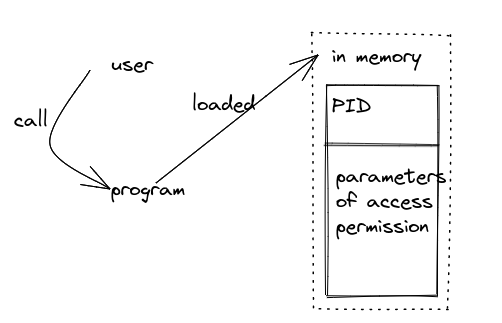Note of Charpter 16, VBird Linux
ALl events triggered on Linux can be taken as a process with a given PID, and it is with access permission accorrding to who triggerred the process.
16.1 Process and Program
Binary file is a program, one user run the program then a process is triggered with PID. Each program has three groups of access permission, each group witch coresponding r/w/x access. So when different user run the same program, will be granted with different permissions. For example, when root run touch a file, root gets UID/GID =0/0, when common_user run touch, it gets UID/GID = 501/501 Then OS will decide if the process has access permission by PID.
flowchart LR
A["bin/bash"]-->|called_by_root| B["PID:1234 User/Group:root/root"]
A["bin/bash"]-->|called_by_mike| C[PID:2234]
A["bin/bash"]-->|called_by_tom| D[PID:3234]
- Program : binary program save in hard drive
- Process : triggerred by a user, with PID
Parent Process : process and child process, like
touchis called in bash, then bash is the parent procss1
ps -lreturn something like below , PPID is parent PID
1 2 3
F S UID PID PPID C PRI NI ADDR SZ WCHAN TTY TIME CMD 0 S 913142 649467 649457 0 80 0 - 11564 sigsus pts/1 00:00:00 zsh 4 R 913142 672184 649467 0 80 0 - 3714 - pts/1 00:00:00 ps
- Service/Daemon : process runing in memory such as crond, atd, rsyslogd, normally daemon end with ‘d’
Multi Users Multi Tasks in Linux
- Each logined user gets a sperate shell (default is /bin/bash), which can be configured in file ~/.bashrc.
- Multi login windows (6 text + 1 GUI), witch with ALT + F1…F7
16.2 Job Control
Bash environment of tty1 and tty2…tty7 are indepent. Which mean bash can only control jobs running in its own environment.
When a user login with a bash, all commands run in this bash would be child process of this bash, run command in background, so this bash still can be used to run other commands
1
cp file1 file2 &
Suppose there is only one terminal, commands can run in
- Forground: interactive, with prompt characters
- Background: cannot interact with users, no prompt characters, commands can be paused or runing, cannot be stopped by ctrl+c. vim cannot be in background.
Job control commands:
Start a command in background , command end with
&. Combine with data redirect , to save output a log file.1 2
# zip folder /etc, any output would be saved to log file /tmp/log.txt, and run in background tar -zpcf /tmp/etc.tar.gz /etc > /tmp/log.txt 2>&1 &
Pause current job and send to background
ctrl + zCheck all jobs in background
jobs -lGet last job in background to foreground
fg, if there’re over one jobs in background, need to specify which job by job numberfg NStart the paused background job
bgKill a background job
kill -signal %jobnumaber1 2 3 4 5 6 7
# % before jobnumber cannot be omitted kill -15 %2 common used `signal` : cheak all the signals `kill -l` -1 : reread job's config file -9 : force delete a job -15 : end the job in a normal way
Sample : Put 2 jobs to background vi , and find in sequence. And get vi to foreground.
1
2
3
4
5
# put 2 jobs to backround
vi ~/.bashrc
ctrl +z
find / -pirnt
ctrl +z
Output of jobs l
1
2
3
# + means the last one put to background, - means the second last put to background
[1]- Stopped vi ~/.bashrc
[2]+ Stopped find / -pirnt
Get vi to foreground again
1
2
# %1 is the job number
fg 1
Offline job management
Previous meaned forground/background is bounded to terminal, not system background job, if you remotely ssh to a linux system, start a background job , but exit remote login before the job ends, then job would also end. If you want the job to continue after you logout, then try nohup
16.3 Process Management
Check current process status statically.
Check process status dynamically. top, htop, pstree
Control process by send a signal, check all signals with kill -l.
kill -signal %jobnumber or kill -signal PID If want to send signal to a process, need to konw the job number or PID, so command kill normally combined with ps.
Or use killall and command name.
killall -i -9 bash
free -h Check system memory resource(-h system decide memory unit)
uname -a info about system and kernal version
16.4 Special file and process
/proc , all processes are in memory, and memory data is writen to directory /proc. /proc/PID, so systemd’s data is saved to /proc/1/, as systemd is the first process when OS started, its PID is 1.
